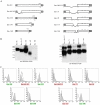Identification of the hASCT2-binding domain of the Env ERVWE1/syncytin-1 fusogenic glycoprotein
- PMID: 16820059
- PMCID: PMC1524976
- DOI: 10.1186/1742-4690-3-41
Identification of the hASCT2-binding domain of the Env ERVWE1/syncytin-1 fusogenic glycoprotein
Abstract
The cellular HERV-W envelope/syncytin-1 protein, encoded by the envelope gene of the ERVWE1 proviral locus is a fusogenic glycoprotein probably involved in the formation of the placental syncytiotrophoblast layer. Syncytin-1-induced in vitro cell-cell fusion is dependent on the interaction with hASCT2. As no receptor binding domain has been clearly defined in the SU of neither the HERV-W Env nor the retroviruses of the same interference group, we designed an in vitro binding assay to evaluate the interaction of the HERV-W envelope with the hASCT2 receptor. Using truncated HERV-W SU subunits, a region consisting of the N-terminal 124 amino acids of the mature SU glycoprotein was determined as the minimal receptor-binding domain. This domain contains several sub-domains which are poorly conserved among retroviruses of this interference group but a region of 18 residus containing the SDGGGX2DX2R conserved motif was proved to be essential for syncytin-1-hASCT2 interaction.
Figures



Similar articles
-
Functional characterization of the placental fusogenic membrane protein syncytin.Biol Reprod. 2004 Dec;71(6):1956-62. doi: 10.1095/biolreprod.104.033340. Epub 2004 Jul 21. Biol Reprod. 2004. PMID: 15269105
-
Endogenous retroviral syncytin: compilation of experimental research on syncytin and its possible role in normal and disturbed human placentogenesis.Mol Hum Reprod. 2004 Aug;10(8):581-8. doi: 10.1093/molehr/gah070. Epub 2004 Jun 4. Mol Hum Reprod. 2004. PMID: 15181178 Review.
-
Synthesis, assembly, and processing of the Env ERVWE1/syncytin human endogenous retroviral envelope.J Virol. 2005 May;79(9):5585-93. doi: 10.1128/JVI.79.9.5585-5593.2005. J Virol. 2005. PMID: 15827173 Free PMC article.
-
The envelope glycoprotein of human endogenous retrovirus type W uses a divergent family of amino acid transporters/cell surface receptors.J Virol. 2002 Jul;76(13):6442-52. doi: 10.1128/jvi.76.13.6442-6452.2002. J Virol. 2002. PMID: 12050356 Free PMC article.
-
Functions of the fusogenic and non-fusogenic activities of Syncytin-1 in human physiological and pathological processes.Biochem Biophys Res Commun. 2025 May 1;761:151746. doi: 10.1016/j.bbrc.2025.151746. Epub 2025 Apr 2. Biochem Biophys Res Commun. 2025. PMID: 40188598 Review.
Cited by
-
Syncytin-1 nonfusogenic activities modulate inflammation and contribute to preeclampsia pathogenesis.Cell Mol Life Sci. 2022 May 10;79(6):290. doi: 10.1007/s00018-022-04294-2. Cell Mol Life Sci. 2022. PMID: 35536515 Free PMC article. Review.
-
Effects of individually silenced N-glycosylation sites and non-synonymous single-nucleotide polymorphisms on the fusogenic function of human syncytin-2.Cell Adh Migr. 2016 Mar 3;10(1-2):39-55. doi: 10.1080/19336918.2015.1093720. Epub 2016 Feb 6. Cell Adh Migr. 2016. PMID: 26853155 Free PMC article.
-
The Roles of Syncytin-Like Proteins in Ruminant Placentation.Viruses. 2015 Jun 5;7(6):2928-42. doi: 10.3390/v7062753. Viruses. 2015. PMID: 26057168 Free PMC article. Review.
-
The mouse IAPE endogenous retrovirus can infect cells through any of the five GPI-anchored Ephrin A proteins.PLoS Pathog. 2011 Oct;7(10):e1002309. doi: 10.1371/journal.ppat.1002309. Epub 2011 Oct 20. PLoS Pathog. 2011. PMID: 22028653 Free PMC article.
-
HERV Envelope Proteins: Physiological Role and Pathogenic Potential in Cancer and Autoimmunity.Front Microbiol. 2018 Mar 14;9:462. doi: 10.3389/fmicb.2018.00462. eCollection 2018. Front Microbiol. 2018. PMID: 29593697 Free PMC article. Review.
References
-
- Blond JL, Lavillette D, Cheynet V, Bouton O, Oriol G, Chapel-Fernandes S, Mandrand B, Mallet F, Cosset FL. An envelope glycoprotein of the human endogenous retrovirus HERV-W is expressed in the human placenta and fuses cells expressing the type D mammalian retrovirus receptor. J Virol. 2000;74:3321–3329. doi: 10.1128/JVI.74.7.3321-3329.2000. - DOI - PMC - PubMed
MeSH terms
Substances
LinkOut - more resources
Full Text Sources
Other Literature Sources
Research Materials

